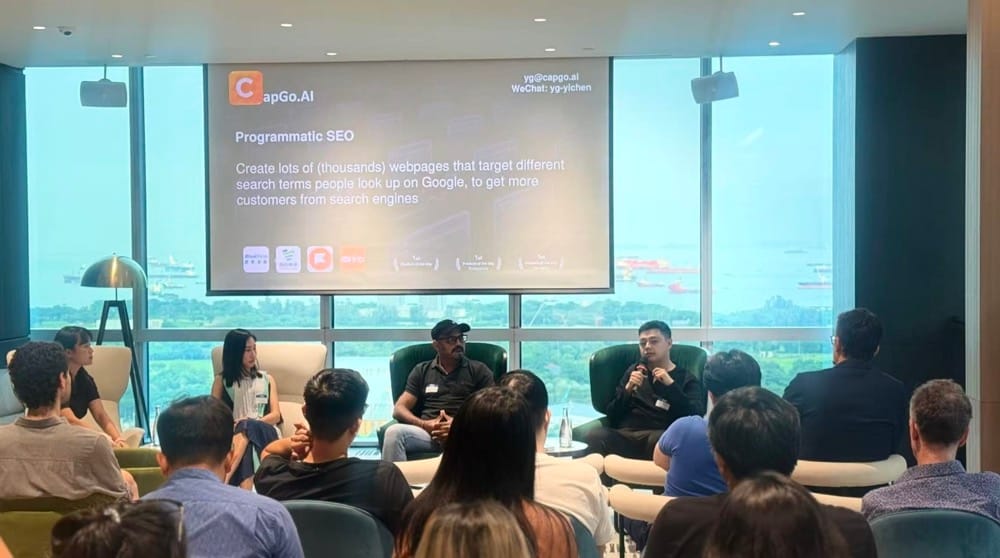How to Use Framer for Programmatic SEO: A Complete Guide (CAPGO AI Collaboration Case Study)

With the rise of low-code website building tools, Framer is no longer just a toy for designers, but has become a powerful tool for content creators and growth hackers in programmatic SEO. This article will provide an in-depth explanation of how to bulk-generate SEO pages in Framer, import structured content, and achieve rapid ranking and traffic growth. It will also introduce the actual workflow in collaboration with CAPGO AI.
🌱 What is programmatic SEO?
Programmatic SEO refers to the automated generation of a large number of search engine optimization (SEO)- friendly pages using templates and data.
For example:
| Search Term | Page Content |
|---|---|
| Best AI Writing Tool | Page comparing multiple AI writing tools |
| Xiaohongshu Marketing Agencies 2024 | Page providing a list and introduction of relevant companies |
These pages have the same structure but different content—this is the core of programmatic SEO.
🛠 Why is Framer suitable for programmatic SEO?
Framer supports the following key capabilities:
- ✅ CMS Collection System (Collections): Build reusable dynamic templates
- ✅ Support CSV/Excel bulk data import
- ✅ Real-time synchronization with Google Sheets/Airtable via plugins
- ✅ Flexible SEO settings: Customize URLs, titles, meta descriptions, OG images, etc.
- ✅ AI plugins (such as FlareRank) for automatic content generation
📦 Practical process: Complete programmatic SEO in 5 steps
Step 1: Plan your page structure and keywords
- For example, if you want to create a “tool recommendation” site:
URL examples:/ai-tools/notion、/ai-tools/grammarly - Recommended data structure (CSV table header):
slugtool_namedescriptionimage_urlprosconsmeta_titlemeta_description
Step 2: Create a CMS Collection in Framer
- Open Framer and go to the CMS panel.
- Create a new Collection, such as
Tools - Add fields corresponding to the columns in your CSV table, for example:
- Text field:
tool_name - Image field:
image_url - Rich text field:
description
- Text field:
Step 3: Design your template page
- Create a page
/ai-tools/[slug] - Use CMS dynamic binding to display content on the page (via the
Get CMS Datafeature) - Set SEO field bindings (Meta Title, Meta Description)
Example: Set Meta Title to Best AI Tool: {tool_name} | YourBrandStep 4: Bulk import content
There are three ways to import data:
- ✅ CSV upload (officially supported)
- Prepare a CSV file in UTF-8 format (maximum 5MB)
- Click “Import” in the CMS panel and select the file
- Automatically generate corresponding pages based on the
slugfield
- ✅ Plugin: CSV Import plugin
- Provides field mapping, import logs, image download prompts, etc.
Step 5: Publish and submit your sitemap
- Framer will automatically generate sitemap.xml
- Ensure that your pages are published and indexable (check robots.txt and noindex settings)
- Submit your sitemap in Google Search Console
🚀 Advanced Techniques
✅ Internal Linking Strategy
- Add a “Related Recommendations” section to the template to automatically recommend other CMS items
✅ Combine Google Trends / Ahrefs for Keyword Selection
- Use trend analysis tools to select long-tail keywords
- Use ChatGPT or AI tools to expand content
🧠 Practical example: AI tool directory site
Suppose you want to create an “AI tool navigation website”:
- Prepare 300 AI tool names, descriptions, and pros and cons.
- Write a CSV file and upload it to Framer.
- Automatically generate an SEO-optimized page for each tool.
- Launch 300+ content pages within a few days and capture a large number of long-tail keywords.
🤝 Workflow for collaborating with CAPGO AI
If you are collaborating with CAPGO AI on a programmatic SEO project, we recommend following the workflow below:
- The client is responsible for designing the Framer page framework:
The client needs to first set up the website structure and templates in Framer, including CMS fields, layouts, styles, etc. - CAPGO is responsible for generating content:
CAPGO will use AI to bulk-generate content based on your requirements (keywords, industry, structural requirements, etc.), outputting it as a standardized JSON format file. - CAPGO provides recommendations on webpage structure and content:
In addition to generating text, CAPGO will also provide professional recommendations on page layout, module division, content order, internal links, etc., ensuring that the page is not only visually appealing but also aligns with SEO best practices. - Clients convert JSON to CSV:
Clients or development teams need to convert the JSON data into the CSV format supported by Framer and upload it to the CMS.
This collaboration process is particularly suitable for corporate websites, vertical information sites, tool navigation sites, and other platforms that require rapid deployment of a large volume of long-tail content.
CAPGO AI and Framer Collaboration Process
Client Designs
Framer Framework→CAPGO Generates Content,
and Exports JSON→Client Converts JSON
to CSV→CSV Uploaded to
Framer CMS
✅ Summary
| Step | Tool | Description |
|---|---|---|
| Data Preparation | Excel / Google Sheets / CAPGO JSON | Structured Content |
| Page Template | Framer CMS + Dynamic Binding | Unified Design |
| Content Upload | CSV / Plugin / Sheets Sync | Automated Generation |
| SEO Optimization | Meta Title, Description, Link Structure | Improve Ranking |
| Content Generation | CAPGO AI / FlareRank | Efficient Content Filling |
Framer + CAPGO = Aesthetic + Efficient + Automated Programmatic SEO Workflow



